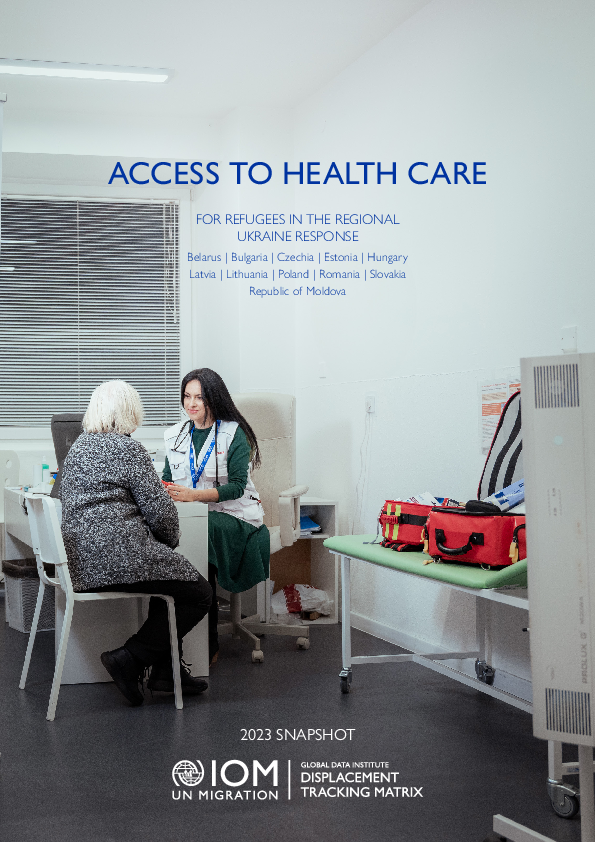-
Countries
-
Data and Analysis
-
Special Focus
-
Crisis Responses
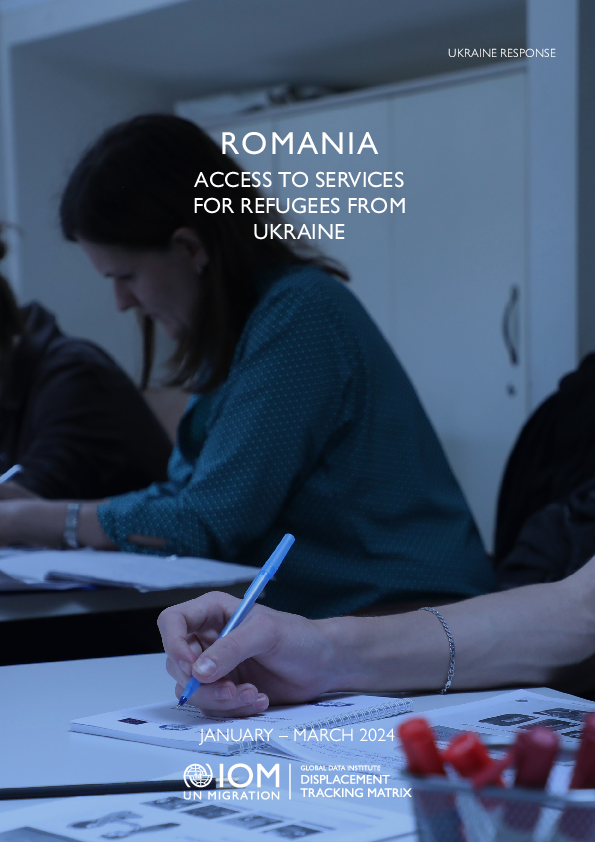
Contact
DTM Europe, DTMMediterranean@iom.int
Language
English
Location
Romania
Period Covered
Jan 01 2024
Mar 31 2024
Activity
- Survey
- Flow Monitoring
IOM’s Displacement Tracking Matrix (DTM) collected data on the needs, intentions, and integration challenges of refugees as part of the Surveys with Refugees in the Ukraine Response Region exercise. From January to March 2024 (Q1), DTM interviewed a total of 437 individuals in Romania, all of whom were Ukrainian except one. This report presents the findings of surveys with 436 adult Ukrainian nationals, including access to services that facilitate integration, and need and assistance.
Key findings:
- Migration status
- 93% EU Temporary protection status
- 7% Other Active population:
- Household (HH) composition
- At least 2 adults and 1 child – 38%
- A single adult and at least 1 child – 21%
- Alone – 21%
- At least two adults and no children – 19%
- Other – 1%
- Children
- 65% - HH with children
- 68 % - children aged between 5 and 17 years old
- 32% - infants aged between 0 and 4 years old
- Needs
- Financial support (73%)
- Sanitary products (56%)
- Food supply (53%)
- Health services (53%)
- Employment (31%)
- Obstacles in accessing healthcare
- Language barrier 43%
- None 38%
- Cost 29%
- Long queues 17%
- Unavailable Services 8%
- Ease of visiting a doctor
- Very difficult 8%
- Somewhat difficult 31%
- Neither easy, nor difficult 30%
- Somewhat easy 13%
- Very easy 1%
- Unknown 17%
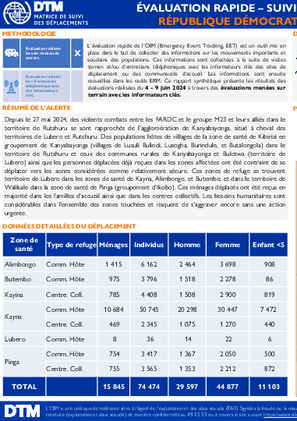
Contact
DTM Support — iomdrcdtm@iom.int
Language
French
Location
Democratic Republic of the Congo
Period Covered
Jun 04 2024
Jun 09 2024
Activity
- Mobility Tracking
- Event Tracking
Depuis le 27 mai 2024, des violents combats entre les FARDC et le groupe M23 et leurs alliés dans le territoire de Rutshuru se sont rapprochés de l’agglomération de Kanyabayonga, situé à cheval des territoires de Lubero et Rutshuru. Des populations hôtes de villages de la zone de santé de Kibirizi en groupement de Kanyabayonga (villages de Lusuli Bulindi, Lusogha, Burindule, et Butalongola) dans le territoire de Rutshuru et ceux des communes rurales de Kanyabayonga et Bulotwa (territoire de Lubero) ainsi que les personnes déplacées déjà reçues dans les zones affectées ont été contraint de se déplacer vers les zones considérées comme relativement sécure. Ces zones de refuge se trouvent territoire de Lubero dans les zones de santé de Kayna, Alimbongo, et Butembo; et dans le territoire de Walikale dans la zone de santé de Pinga (groupement d’Ikobo). Ces ménages déplacés ont été reçus en majorité dans les familles d’accueil ainsi que dans les centres collectifs. Les besoins humanitaires sont considérables dans l'ensemble des zones touchées et risquent de s'aggraver encore sans une action urgente.
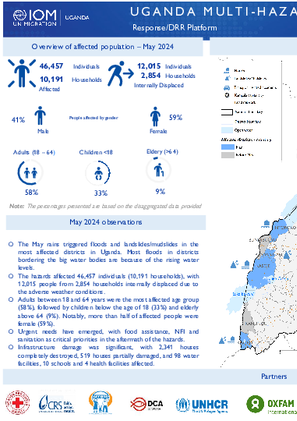
Contact
DTM Uganda, dtmuganda@iom.int
Language
English
Location
Uganda
Period Covered
May 01 2024
May 31 2024
Activity
- Mobility Tracking
The May rains triggered floods and landslides/mudslides in the most affected districts in Uganda. Most floods in districts bordering the big water bodies are because of the rising water levels. The hazards affected 46,457 individuals (10,191 households), with 12,015 people from 2,854 households internally displaced due to the adverse weather conditions. Adults between 18 and 64 years were the most affected age group (58%), followed by children below the age of 18 (33%) and elderly above 64 (9%). Notably, more than half of affected people were female (59%). Urgent needs have emerged, with food assistance, NFI and sanitation as critical priorities in the aftermath of the hazards.
Infrastructure damage was significant, with 2,341 houses completely destroyed, 519 houses partially damaged, and 98 water facilities, 10 schools and 4 health facilities affected.
It is important to note that the information presented in the dashboard is derived solely from the represented districts, and no other major hazard events were reported from other districts.
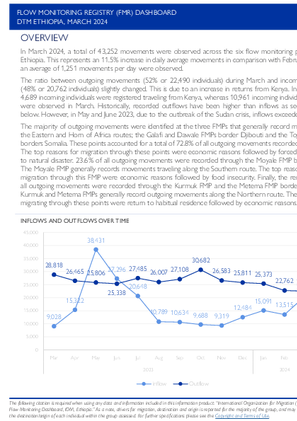
Contact
DTM Ethiopia, DTMEthiopia@iom.int
Language
English
Location
Ethiopia
Period Covered
Mar 01 2024
Mar 31 2024
Activity
- Flow Monitoring
In March 2024, a total of 43,252 movements were observed across the six flow monitoring points (FMPs) in Ethiopia. This represents an 11.5% increase in daily average movements in comparison with February 2024 when an average of 1,251 movements per day were observed.
The ratio between outgoing movements (52% or 22,490 individuals) during March and incoming movements (48% or 20,762 individuals) slightly changed. This is due to an increase in returns from Kenya. In February 2024, 4,689 incoming individuals were registered traveling from Kenya, whereas 10,961 incoming individuals from Kenya were observed in March. Historically, recorded outflows have been higher than inflows as seen in the figure below. However, in May and June 2023, due to the outbreak of the Sudan crisis, inflows exceeded outflows.
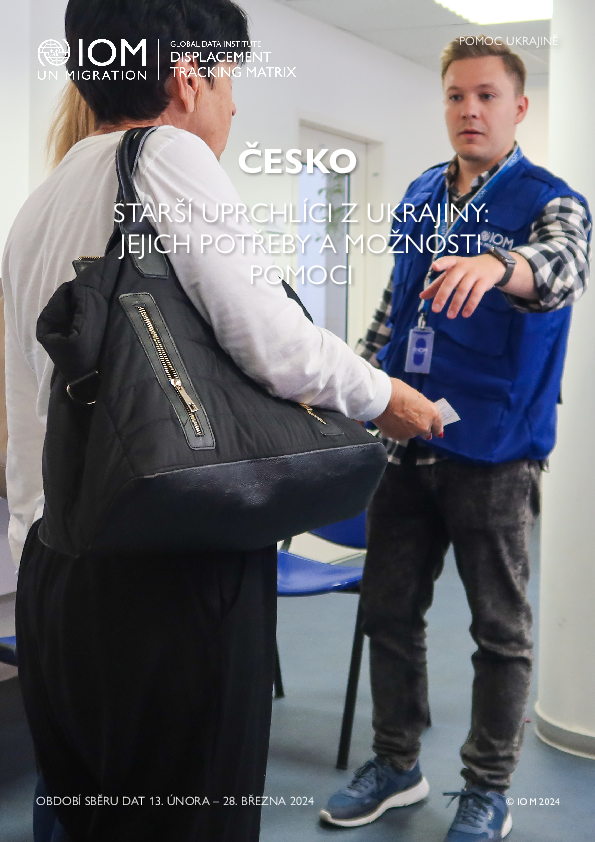
Contact
DTM Europe, DTMMediterranean@iom.int
Language
Czech
Location
Czechia
Period Covered
Feb 13 2024
Mar 28 2024
Activity
- Survey
- Flow Monitoring
K 1. dubnu 2024 bylo v Česku podle vnitrostátních orgánů registrováno 338 736 uprchlíků z Ukrajiny, kteří žádali o dočasnou ochranu. Tato zpráva vychází ze smíšeného výzkumu se staršími uprchlíky, skupinou, která byla v předchozích výzkumech, označena za jednu z nejzranitelnějších. Ukazuje, že ekonomická soběstačnost a jazyková adaptace mohou být pro tyto osoby problematické. V důsledku toho jsou často závislí na vnější podpoře, kterou jim ve většině případů poskytují jejich rodinní příslušníci. Mnozí z nich, bez ohledu na svůj věk, chtějí pracovat a nebýt pro svou rodinu nebo společnost přítěží. To však může být náročné a pouze 12 % z nich má práci. Ti, kteří nepracují, často pečují o děti nebo postižené členy rodiny nebo se snaží být užiteční jiným způsobem. Tento způsob přínosu je potřeba uznat.
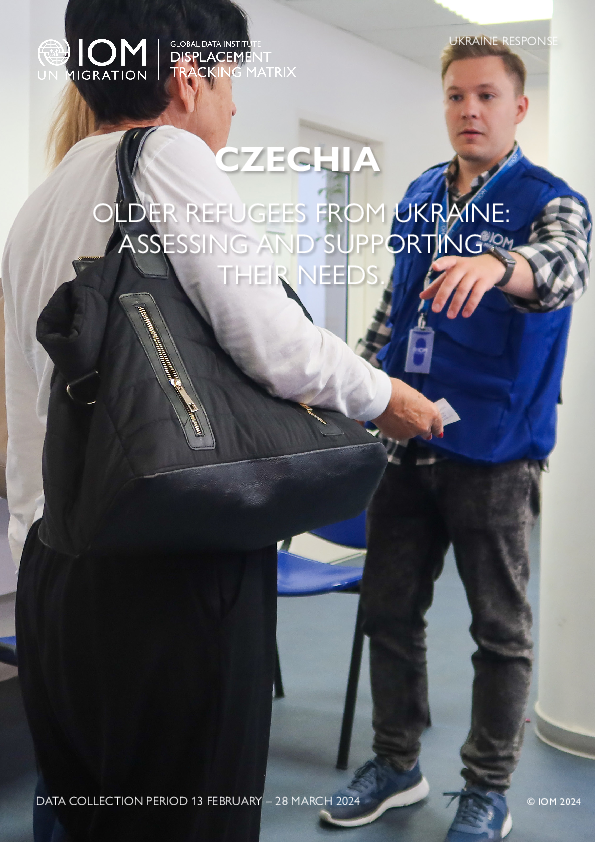
Contact
DTM Europe, DTMMediterranean@iom.int
Language
English
Location
Czechia
Period Covered
Feb 13 2024
Mar 28 2024
Activity
- Survey
- Flow Monitoring
This report is based on a mixed method study conducted among older refugees, a group that has been identified by previous research, including that of IOM, as being among the most vulnerable. It shows that economic self-reliance and language adaptation can be problematic for these individuals. Consequently, they often depend on external support, which in most cases, is provided by their family members. Many of them, regardless of their age, want to work, and not to be a burden to their families or society.
Data collection took place between the dates of 13 February and 28 March 2024, resulting in 403 interviews with refugees from Ukraine. In 128 cases, additional information was collected during the qualitative interview phase.
Key Findings
- 77% of respondents had serious health specific needs
- 73% were registered with a general health practitioner
- Only 12% were employed, where 29% were working without a written contract
- 50% of employed respondents were working 160 hours or more per month
- One-third of respondents could speak Czech (35% of women, 30% of men)
- Over half the respondents couldn’t afford 2,500 CZK as an unexpected expense
- Two-thirds of respondents have a monthly household income of less than 12,500 CZK
- 82% of respondents reported at least one priority need
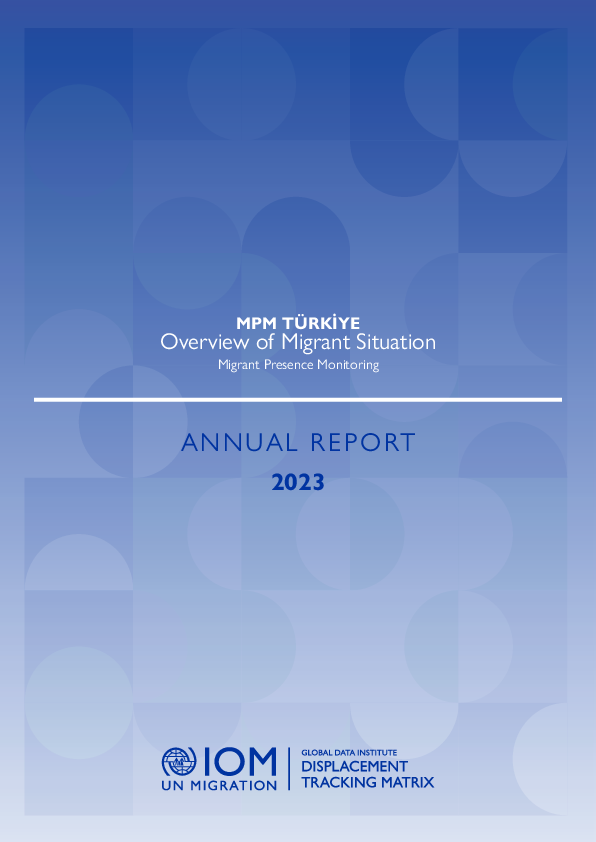
Contact
DTM Türkiye, mpmturkey@iom.int
Language
English
Location
Republic of Türkiye
Period Covered
Jan 01 2023
Dec 31 2023
Activity
- Flow Monitoring
- Migrants presence
According to the latest figures from the Turkish Presidency of Migration Management (PMM), there are more than 4.6 million foreigners in Türkiye, of whom 3.5 million are seeking international protection. Most of them are Syrians (3,214,780 individuals: 3,150,899 urban caseload and 63,881 residing in camps) who have been granted temporary protection status. There is an increase of 16,356 individuals in the number of Syrian nationals staying in camps in comparison to last year's figures.
According to the United Nations High Commissioner for Refugees (UNHCR), there were 296,685 refugees and asylum-seekers in Türkiye as of mid of 2023.
In addition, 1,107,032 foreigners present in Türkiye holding residency permits including short-term residence permit, family residence permit, student residence permit, longterm residence permit, humanitarian residence permit and residence permit for victims of human trafficking.
According to PMM, 254,008 migrants in an irregular situation of different nationalities were apprehended in Türkiye in 2023.4 Please see Page 4 for more details.
From January to December 2023, IOM’s Displacement Tracking Matrix (DTM) collected data on the Needs, Intentions, and Integration Challenges of refugees from Ukraine and Third-Country Nationals (TCNs) in 11 countries in the Ukraine Response: Belarus, Bulgaria, Czechia, Estonia, Hungary, Latvia, Lithuania, Poland, Republic of Moldova, Romania, and Slovakia. Over the course of 2023, a sample of a total of 28,712 respondents were surveyed on displacement patterns and experiences, including access and barriers to health care.
Key Findings
- One-third (34%) of respondents stayed with at least one person (including themselves) with a chronic condition.
- 16% of respondents had or accompanied someone with at least one disability in 2023.
- Across all 11 countries, 54% of the people interviewed faced one or more challenges to accessing health care.
- Top barriers included long waiting times (30%) and the language barrier (23%).
- Top health needs reported were health-care services (41%), medicines (29%) and psychological counselling (5%).
- 37% of households needed to pay for both health-care services and medicine.
- 42% of respondents needed more information on health-care services, 17% on psychological counselling and 12% on medicine.
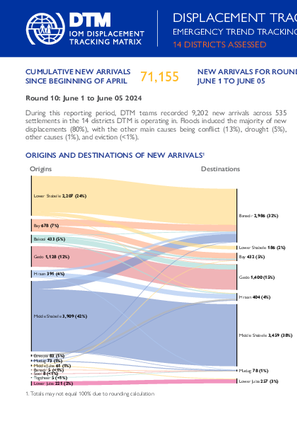
Contact
DTM Somalia, IOMSomaliaDTM@iom.int
Language
English
Location
Somalia
Period Covered
Jun 01 2024
Jun 05 2024
Activity
- Mobility Tracking
- Baseline Assessment
This latest round of Emergency Trends Tracking was initiated in April 2024 to monitor displacements movements during the Gu rainy season. Districts covered in this round include Afgooye, Afmadow, Baardheere, Baidoa, Balcad, Belet Weyne, Dayniile, Gaalkacyo, Hodan, Jamaame, Jowhar, Kahda, Kismaayo, Luuq.
ETT is a crisis-based tool that tracks sudden displacement triggered by specific events or emerging crises. The objective of ETT is to help prioritize humanitarian response and to enable partners to deliver rapid assistance. Based on previous shock induced displacement patterns, the humanitarian community expects that people will continue to move toward urban areas in search of humanitarian services. Consequently, the ETT coverage focuses on the main urban centers and surrounding villages for each assessed district. The data is collected through Key Informant Interviews (KIIs) at the location level, from Sunday to Wednesday every week. It includes information on new arrivals, numbers and demographic of IDPs, reasons for displacement, intentions, humanitarian assistance and priority needs among others.
The ETT tool also adapts to regional contexts: because of the very high number of IDP sites in Khada and Daynile districts in Banadir region and in Baidoa district in Bay region, a zonal approach has been adopted for these areas. Each week, KIIs are first conducted at the zone level to indicate to the field teams which locations have received the most new arrivals and which need to be assessed.
To facilitate the joint analysis of the CCCM (Camp Coordination and Camp Management) Cluster’s New Arrivals Tracker (NAT) and ETT data, the assistance and needs indicators are identical in both tools.
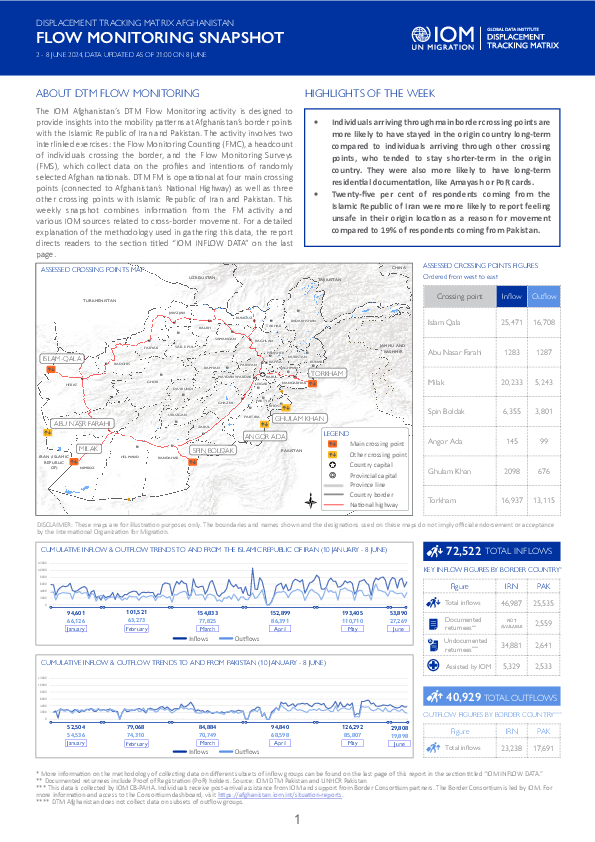
Contact
DTMAfghanistan@iom.int
Language
English
Location
Afghanistan
Period Covered
Jun 02 2024
Jun 08 2024
Activity
- Survey
- Flow Monitoring Survey
- Flow Monitoring
The IOM Afghanistan’s DTM Flow Monitoring activity is designed to provide insights into the mobility patterns at Afghanistan’s border points with the Islamic Republic of Iran and Pakistan. The activity involves two interlinked exercises: the Flow Monitoring Counting (FMC), a headcount of individuals crossing the border, and the Flow Monitoring Surveys (FMS), which collect data on the profiles and intentions of randomly selected Afghan nationals. DTM FM is operational at four main crossing points (connected to Afghanistan’s National Highway) as well as three other crossing points with Islamic Republic of Iran and Pakistan. This weekly snapshot combines information from the FM activity and various IOM sources related to cross-border movement. For a detailed explanation of the methodology used in gathering this data, the report directs readers to the section titled “IOM INFLOW DATA” on the last page.
